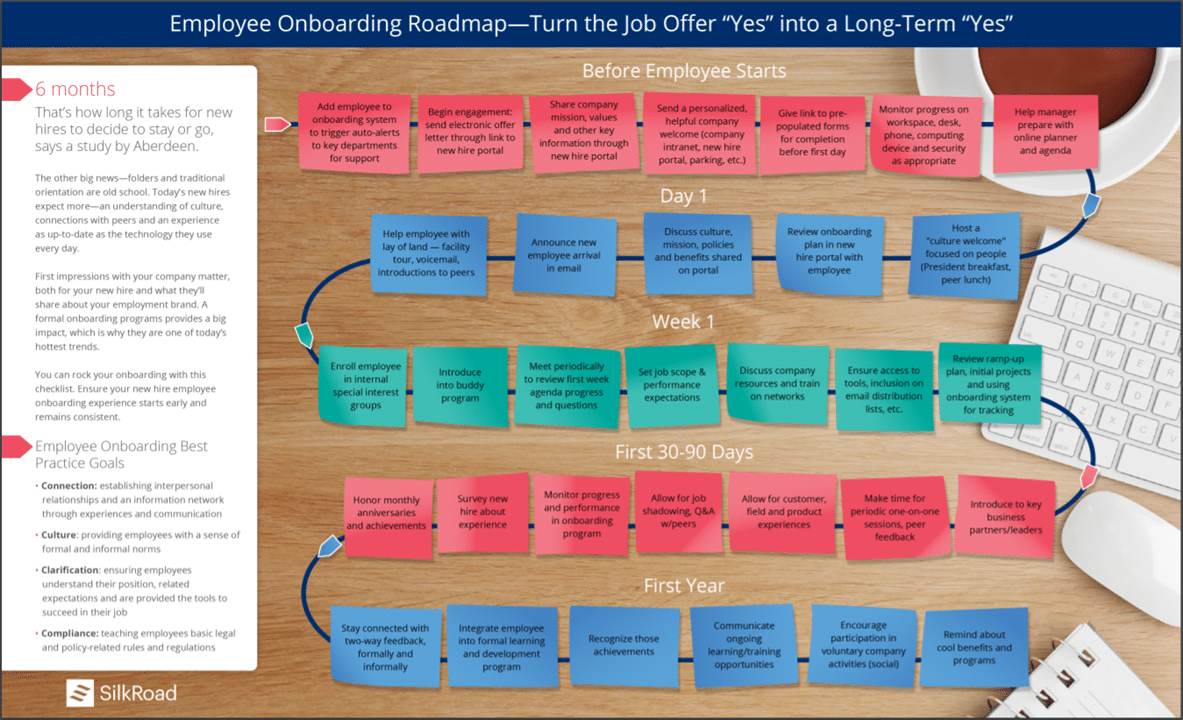How to Assess Your Company’s Onboarding Program
(Editor’s Note: Today’s post is brought to you by our friends at SilkRoad, a provider of talent activation technology. Be sure to check out their “Top Sources of Hire 2017” report, which lists the top seven sources of new hires. It’s a must-read for any talent acquisition professional. Enjoy the post!)
Regardless of what we call it, we know what onboarding is. It’s the process new hires (or newly promoted employees) go through to become productive. The question becomes do organizations know how well onboarding does for them? There’s only one way to find out the effectiveness the company’s onboarding process. That’s by conducting an assessment.
Today’s post is designed to provide an outline for assessing your onboarding program. I hope you’ll bookmark this page for future reference and use it to regularly evaluate your program’s effectiveness.
4 Steps for Assessing Your Onboarding Program
During a program assessment, there are four areas that organizations need to examine: objectives, content, employees, and managers. Let’s talk about each of them.
Remember goals and objectives. Companies want to ask themselves, “What’s the purpose of our onboarding program?”. We’re not talking about the definition of onboarding here. The purpose of a company’s onboarding program might be a little different in each organization. Meaning the purpose could be to “make new hires productive and…” It might include a compliance component. Or some sort of socialization piece. The objective might also mention pre-boarding and orientation.
Organizations might want to consider reviewing program goals and objectives once a year. Make it a part of the budget development process, in case you need to request resources to grow or improve the program.
Evaluate the content. Think about the program materials from two perspectives. First, is the content current? I am sometimes amazed that companies implement new policies and forget to update training programs as part of the roll-out. Companies should have a process in place so onboarding content doesn’t become outdated. Make sure that the person or department responsible for updating content is provided with the information they need. The second aspect is to review the content to ensure alignment between the program goals and the content. It doesn’t necessarily mean the content needs to be changed, but it could mean that the sequence does.
If you schedule onboarding sessions regularly, keeping the content current might not be an issue for you. But if you only conduct onboarding activities quarterly, it might make sense to build extra time into the program schedule for a content review prior to each time it’s delivered.
Survey employees. New hires have a fresh perspective on everything. This is a great opportunity for feedback. Ask employees if they feel the organization is making an investment in their future. Onboarding should send that message.
I’m a fan of surveying new hires after orientation, after their introductory period, six months and one year. You can use a combination of techniques such as online surveys, focus groups, and one-on-one meetings. Find out if employees feel they are getting the information they need at the moment they need it. Onboarding isn’t supposed to be a surprise. Companies might want to provide new hires with an onboarding roadmap to set expectations.
Survey managers. Trust me, managers have an opinion about the onboarding process. They have a first impression of the new hire when they arrive to the department after orientation. Is the employee excited and enthused or deflated? Mangers will also have some insights about the new hire’s performance after their introductory period.
Find time to have regularly scheduled one-on-one meetings with managers to talk about talent. This conversation should focus on recruiting, onboarding, training, etc. Ask managers if they feel employees are coming to the department prepared? Share with them a copy of the employee’s onboarding roadmap. They should know the contents and support it. And speaking of support, make sure that managers have all the resources they need to continue the process after company orientation. Ask what help or assistance they need from HR.
Regular Reviews of Onboarding Keep the Program at its Best
Even though I included the word “assessment” in the title, I know sometimes labeling something an assessment can be a negative. These activities don’t have to be labeled “assessments”. Just make it a practice. The organization wants to know that onboarding is doing what it’s supposed to do. Because getting it right means that employees are set up for success.
And if you want to learn more about setting employees up for success, join me and the SilkRoad team on Thursday, September 28 at 1p Central / 2p Eastern for a webinar on “How Organizations Can Create a Personalized Onboarding RoadMap for New Hires”. Registration details can be found on the SilkRoad website. Employees want to feel like they’re more than ‘just a number’ when they start. The way to accomplish that is by creating a strategic onboarding program that make new hires feel they are going to be successful.
29